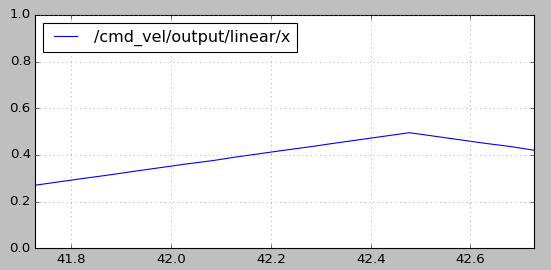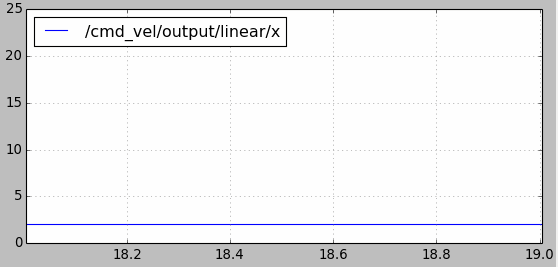使用yocs_velocity_smoother对机器人速度进行限制
yocs_velocity_smoother是一个速度、加速度限制器,用来防止robot navigation的速度/转速过快,加速度/快减速过大。Bound incoming velocity messages according to robot velocity and acceleration limits. The velocity smoother nodelet runs together with the kobuki_node to apply robot's velocity and acceleration limits to the incoming commands before resending them to the robot. It will however also work for any other generic ros mobile base driver.
输入下面命令安装yocs_velocity_smoother或者从GitHub上下载源代码进行编译。
sudo apt-get install ros-kinetic-yocs-velocity-smoother
订阅的话题
- raw_cmd_vel:Input velocity commands. 原始速度指令
- odometry:We compare the output velocity commands to measured velocity to ensure we don't create very big jumps in the velocity profile.
- robot_cmd_vel:Alternatively, we can also compare the output velocity commands to end robot velocity commands to ensure we don't create very big jumps in the velocity profile. See robot_feedback parameter description below for more details.
发布的话题
- smooth_cmd_vel:Smoothed output velocity commands respecting velocity and acceleration limits. 限制幅度后的速度
launch文件
standalone.launch文件先运行一个名为nodelet_manager的nodelet manager节点,然后加载velocity_smoother.launch文件:
<!-- Example standalone launcher for the velocity smoother --> <launch> <arg name="node_name" value="velocity_smoother"/> <arg name="nodelet_manager_name" value="nodelet_manager"/> <arg name="config_file" value="$(find yocs_velocity_smoother)/param/standalone.yaml"/> <arg name="raw_cmd_vel_topic" value="raw_cmd_vel"/> <arg name="smooth_cmd_vel_topic" value="smooth_cmd_vel"/> <arg name="robot_cmd_vel_topic" value="robot_cmd_vel"/> <arg name="odom_topic" value="odom"/> <!-- nodelet manager --> <node pkg="nodelet" type="nodelet" name="$(arg nodelet_manager_name)" args="manager"/> <!-- velocity smoother --> <include file="$(find yocs_velocity_smoother)/launch/velocity_smoother.launch"> <arg name="node_name" value="$(arg node_name)"/> <arg name="nodelet_manager_name" value="$(arg nodelet_manager_name)"/> <arg name="config_file" value="$(arg config_file)"/> <arg name="raw_cmd_vel_topic" value="$(arg raw_cmd_vel_topic)"/> <arg name="smooth_cmd_vel_topic" value="$(arg smooth_cmd_vel_topic)"/> <arg name="robot_cmd_vel_topic" value="$(arg robot_cmd_vel_topic)"/> <arg name="odom_topic" value="$(arg odom_topic)"/> </include> </launch>
在standalone.launch中使用nodelet_manager加载yocs_velocity_smoother/VelocitySmootherNodelet.
<!-- YOCS velocity smoother launcher --> <launch> <arg name="node_name" default="velocity_smoother"/> <arg name="nodelet_manager_name" default="nodelet_manager"/> <arg name="config_file" default="$(find yocs_velocity_smoother)/param/standalone.yaml"/> <arg name="raw_cmd_vel_topic" default="raw_cmd_vel"/> <arg name="smooth_cmd_vel_topic" default="smooth_cmd_vel"/> <arg name="robot_cmd_vel_topic" default="robot_cmd_vel"/> <arg name="odom_topic" default="odom"/> <node pkg="nodelet" type="nodelet" name="$(arg node_name)" args="load yocs_velocity_smoother/VelocitySmootherNodelet $(arg nodelet_manager_name)"> <!-- parameters --> <rosparam file="$(arg config_file)" command="load"/> <!-- velocity commands I/O --> <remap from="$(arg node_name)/raw_cmd_vel" to="$(arg raw_cmd_vel_topic)"/> <remap from="$(arg node_name)/smooth_cmd_vel" to="$(arg smooth_cmd_vel_topic)"/> <!-- Robot velocity feedbacks --> <remap from="$(arg node_name)/robot_cmd_vel" to="$(arg robot_cmd_vel_topic)"/> <remap from="$(arg node_name)/odometry" to="$(arg odom_topic)"/> </node> </launch>
standalone.yaml文件用于配置速度平滑参数:
# Example configuration: # - velocity limits are around a 10% above the physical limits # - acceleration limits are just low enough to avoid jerking # Mandatory parameters speed_lim_v: 0.8 # Linear velocity limit speed_lim_w: 5.4 # Angular velocity limit accel_lim_v: 0.3 # Linear acceleration limit accel_lim_w: 3.5 # Angular acceleration limit # Optional parameters frequency: 20.0 # Output messages rate. The velocity smoother keeps it regardless incoming messages rate, interpolating whenever necessary decel_factor: 1.0 # Deceleration/acceleration ratio. Useful to make deceleration more aggressive # Robot velocity feedback type: # 0 - none # 1 - odometry # 2 - end robot commands robot_feedback: 2
速度限制测试
yocs_velocity_smoothe包的源文件中有一个测试程序,可以测试速度限制的效果。测试launch文件test_translational_smoothing.launch如下:
<!--Tests the velocity smoother with varied translational inputs.--> <launch> <!-- Launch a nodelet manager node --> <node pkg="nodelet" type="nodelet" name="nodelet_manager" args="manager"/> <!-- Launch a nodelet of type pkg/Type on manager manager --> <node pkg="nodelet" type="nodelet" name="velocity_smoother" args="load yocs_velocity_smoother/VelocitySmootherNodelet nodelet_manager" output="screen"> <rosparam file="$(find yocs_velocity_smoother)/param/standalone.yaml" command="load"/> <!-- Subscribed Topics --> <remap from="velocity_smoother/odometry" to="odom"/> <remap from="velocity_smoother/robot_cmd_vel" to="cmd_vel/output"/> <remap from="velocity_smoother/raw_cmd_vel" to="cmd_vel/input"/> <!-- Published Topics --> <remap from="velocity_smoother/smooth_cmd_vel" to="cmd_vel/output"/> </node> <!-- Launch test node --> <node pkg="yocs_velocity_smoother" type="test_translational_input.py" name="test_translational_input" output="screen"> <remap from="test_translational_input/cmd_vel" to="cmd_vel/input"/> <remap from="test_translational_input/odom" to="odom"/> <!--<param name="velocity_maximum" value="0.50"/> --> <param name="ramp_increment" value="0.01"/> <param name="ramp_decrement" value="0.01"/> </node> </launch>
test_translational_input.py程序中根据加速度参数(ramp_increment、ramp_decrement)周期性的调整X方向的移动速度,并将cmd_vel和odom信息发布出去。注意在launch文件中又分别将test_translational_input/cmd_vel和test_translational_input/odom重映射为cmd_vel/input与odom.

#!/usr/bin/env python import roslib roslib.load_manifest('yocs_velocity_smoother') import rospy import os import sys import time from geometry_msgs.msg import Twist from nav_msgs.msg import Odometry ''' Varied translational input for a velocity smoother test. ''' STATE_RAMP_UP = 0 STATE_RAMP_LEVEL = 1 STATE_RAMP_DOWN = 2 STATE_ZERO = 3 STATE_UP = 4 STATE_DOWN = 5 STATE_UP_AGAIN = 6 STATE_NOTHING = 7 def main(): rospy.init_node("test_velocity_smoother_input") cmd_vel_publisher = rospy.Publisher("~cmd_vel", Twist) odom_publisher = rospy.Publisher("~odom", Odometry) param = {} param['velocity_maximum'] = rospy.get_param("~velocity_maximum", 0.50) param['ramp_increment'] = rospy.get_param("~ramp_increment", 0.02) rospy.loginfo("Test Input : ramp increment [%f]",param['ramp_increment']) param['ramp_decrement'] = rospy.get_param("~ramp_decrement", 0.02) rospy.loginfo("Test Input : ramp decrement [%f]",param['ramp_decrement']) cmd_vel = Twist() cmd_vel.linear.x = 0 cmd_vel.linear.y = 0 cmd_vel.linear.z = 0 cmd_vel.angular.x = 0 cmd_vel.angular.y = 0 cmd_vel.angular.z = 0 odom = Odometry() odom.header.frame_id = "base_link" odom.pose.pose.position.x = 0.0 odom.pose.pose.position.y = 0.0 odom.pose.pose.position.z = 0.0 odom.pose.pose.orientation.x = 0.0 odom.pose.pose.orientation.y = 0.0 odom.pose.pose.orientation.z = 0.0 odom.pose.pose.orientation.w = 1.0 odom.pose.covariance[0] = 0.1 odom.pose.covariance[7] = 0.1 odom.pose.covariance[35] = 0.2 odom.pose.covariance[14] = 10.0 odom.pose.covariance[21] = 10.0 odom.pose.covariance[28] = 10.0 odom.twist.twist.linear.x = 0.0 odom.twist.twist.linear.y = 0.0 odom.twist.twist.linear.z = 0.0 odom.twist.twist.angular.x = 0.0 odom.twist.twist.angular.y = 0.0 odom.twist.twist.angular.z = 0.0 state = STATE_RAMP_UP count = 0 count_max = 100 publish = True #period = 0.01 timer = rospy.Rate(100) # 10hz rospy.loginfo("Test Input : STATE_RAMP_UP") while not rospy.is_shutdown(): if state == STATE_RAMP_UP: cmd_vel.linear.x = cmd_vel.linear.x + param['ramp_increment'] if cmd_vel.linear.x >= param['velocity_maximum']: state = STATE_RAMP_LEVEL count = 0 rospy.loginfo("Test Input : STATE_RAMP_UP -> STATE_RAMP_LEVEL") elif state == STATE_RAMP_LEVEL: if count > count_max: # 0.5s state = STATE_RAMP_DOWN count = 0 rospy.loginfo("Test Input : STATE_RAMP_LEVEL -> STATE_RAMP_DOWN") else: count = count + 1 elif state == STATE_RAMP_DOWN: cmd_vel.linear.x = cmd_vel.linear.x - param['ramp_decrement'] if cmd_vel.linear.x <= 0.0: cmd_vel.linear.x = 0.0 state = STATE_ZERO count = 0 rospy.loginfo("Test Input : STATE_RAMP_DOWN -> STATE_ZERO") elif state == STATE_ZERO: if count > count_max: # 0.5s state = STATE_UP cmd_vel.linear.x = param['velocity_maximum'] count = 0 rospy.loginfo("Test Input : STATE_ZERO -> STATE_UP") else: count = count + 1 elif state == STATE_UP: if count > count_max: # 0.5s state = STATE_DOWN cmd_vel.linear.x = 0.0 count = 0 rospy.loginfo("Test Input : STATE_UP -> STATE_DOWN") else: count = count + 1 elif state == STATE_DOWN: if count > count_max: # 0.5s #state = STATE_UP_AGAIN #cmd_vel.linear.x = param['velocity_maximum'] #rospy.loginfo("Test Input : STATE_DOWN -> STATE_UP_AGAIN") state = STATE_RAMP_UP cmd_vel.linear.x = 0.0 rospy.loginfo("Test Input : STATE_DOWN -> STATE_RAMP_UP") count = 0 else: count = count + 1 elif state == STATE_UP_AGAIN: if count > count_max: # 0.5s state = STATE_NOTHING count = 0 publish = False rospy.loginfo("Test Input : STATE_UP_AGAIN -> STATE_NOTHING") else: count = count + 1 elif state == STATE_NOTHING: if count > count_max: # 0.5s state = STATE_RAMP_UP cmd_vel.linear.x = 0.0 count = 0 publish = True rospy.loginfo("Test Input : STATE_NOTHING -> STATE_RAMP_UP") else: count = count + 1 if publish: odom.twist.twist.linear.x = cmd_vel.linear.x cmd_vel_publisher.publish(cmd_vel) else: # How to fake it when it's not publishing a cmd velocity? Up to the velocity controller there odom.twist.twist.linear.x = cmd_vel.linear.x odom.header.stamp = rospy.Time().now() odom_publisher.publish(odom) timer.sleep() if __name__ == "__main__": main()
输入下面的命令运行测试程序:
roslaunch yocs_velocity_smoother test_translational_smoothing.launch
可以使用rqt_plot工具绘制速度变化曲线,在终端中输入下面的命令进行绘制:
rqt_plot /cmd_vel/output/linear/x

可以将默认配置文件中的速度上限(speed_lim_v)从0.8改为0.4,再次运行测试程序。从速度曲线图中可以看出,最大速度已经被限制在0.4m/s

velocity_smoother还可以防止速度指令的跳变引起机器人的抖动。比如使用cmd_vel_mux进行速度切换时,前一个控制速度为2m/s,某一时刻切换到另一个速度假设为15m/s,如果不做处理瞬时加速度会很大。如下图所示,使用velocity_smoother对加速度进行限制,在速度指令跳变时能够使其不超出限制:

另外要注意yocs_velocity_smoother包中使用了动态参数配置的功能(参考ROS的参数应用以及动态调整),在yocs_velocity_smoother/cfg文件夹下的params.cfg文件如下。注意standalone.yaml配置文件中的速度和加速度参数不要超过cfg文件中动态参数的最大值。
#!/usr/bin/env python PACKAGE = "yocs_velocity_smoother" from dynamic_reconfigure.parameter_generator_catkin import * gen = ParameterGenerator() gen.add("speed_lim_v", double_t, 0, "Maximum linear velocity", 1.0, 0.0, 100.0) gen.add("speed_lim_w", double_t, 0, "Maximum angular velocity", 5.0, 0.0, 100.0) gen.add("accel_lim_v", double_t, 0, "Maximum linear acceleration", 0.5, 0.0, 100.0) gen.add("accel_lim_w", double_t, 0, "Maximum angular acceleration", 2.5, 0.0, 100.0) gen.add("decel_factor", double_t, 0, "Deceleration to acceleration ratio", 1.0, 0.0, 10.0) # Second arg is node name it will run in (doc purposes only), third is generated filename prefix exit(gen.generate(PACKAGE, "velocity_smoother_configure", "params"))
params.cfg其实是一个基于python的模块,首先创建一个ParameterGenerator对象,然后调用其add()函数将参数添加到参数列表中。add()的参数含义分别是:参数名,参数类型,级别,描述,缺省值,最小值,最大值。
参考:







【推荐】国内首个AI IDE,深度理解中文开发场景,立即下载体验Trae
【推荐】编程新体验,更懂你的AI,立即体验豆包MarsCode编程助手
【推荐】抖音旗下AI助手豆包,你的智能百科全书,全免费不限次数
【推荐】轻量又高性能的 SSH 工具 IShell:AI 加持,快人一步
· AI与.NET技术实操系列:向量存储与相似性搜索在 .NET 中的实现
· 基于Microsoft.Extensions.AI核心库实现RAG应用
· Linux系列:如何用heaptrack跟踪.NET程序的非托管内存泄露
· 开发者必知的日志记录最佳实践
· SQL Server 2025 AI相关能力初探
· 震惊!C++程序真的从main开始吗?99%的程序员都答错了
· 【硬核科普】Trae如何「偷看」你的代码?零基础破解AI编程运行原理
· 单元测试从入门到精通
· 上周热点回顾(3.3-3.9)
· winform 绘制太阳,地球,月球 运作规律
2017-01-12 奥比中光3D视觉传感器--OpenNI 2配置